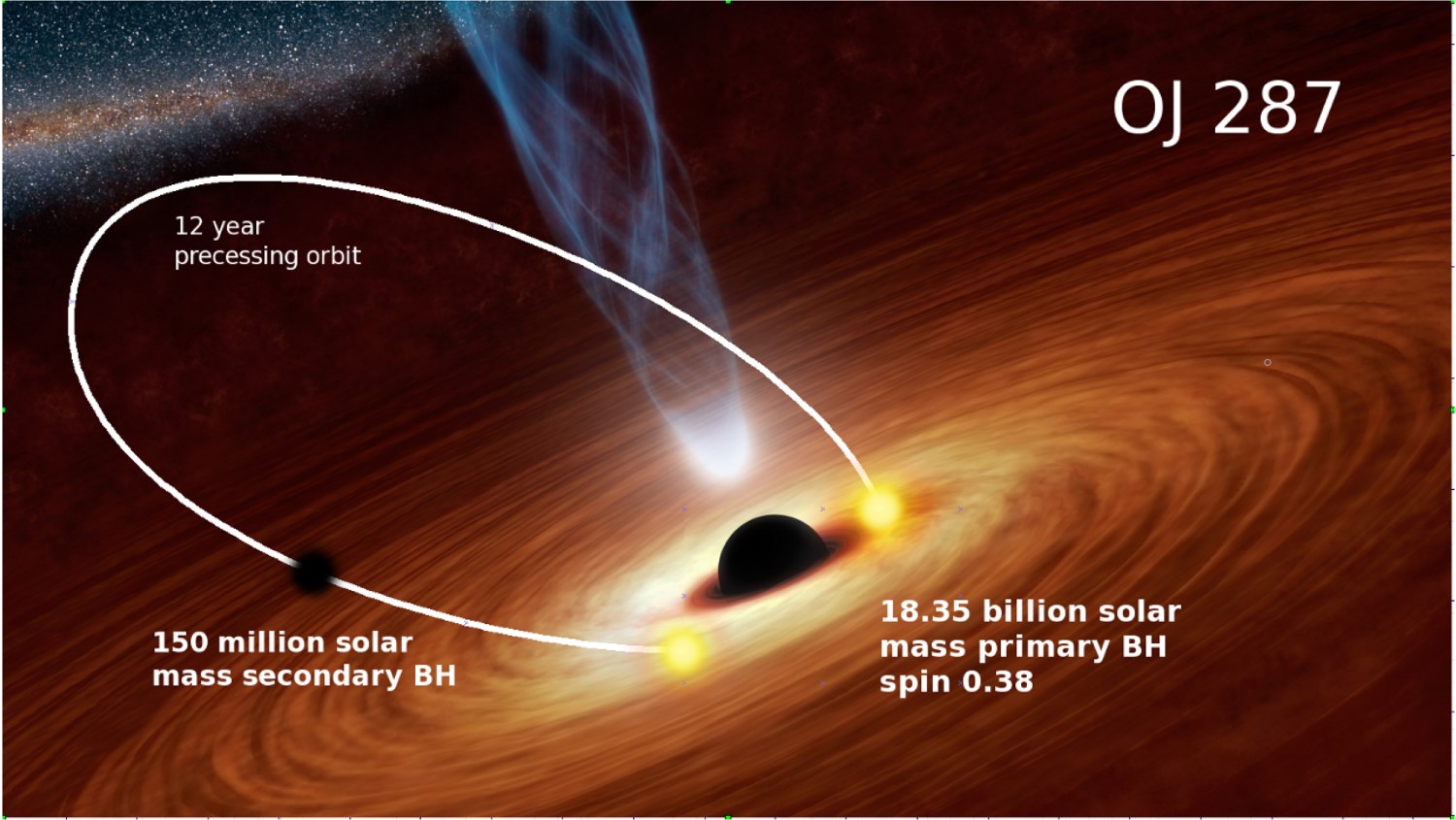Flare of light brighter than a trillion suns reveals location of rare double black hole galaxy
Brilliant new signals from a far-off galaxy confirm that the system is anchored by a pair of black holes locked in a daring dance.

Mysterious flares in the sky brighter than a trillion suns are actually the glow from two distant black holes circling one another, astronomers confirmed in new observations that solve a decades-old mystery.
New research finds that galaxy OJ 287, which sits 5 billion light-years away from Earth in the constellation Cancer, is anchored by two black holes, one supermassive and one smaller. Though these two black holes look like one dot on telescope imagery, they send out different kinds of electromagnetic signals, allowing astronomers to untangle their respective identities.
The galaxy was discovered in 1888, and astronomers have suspected for decades that it might be a binary system, with two black holes at its core. The galaxy shows a pattern of emissions that vary on two separate cycles, one 12 years long and the other 55 years long, suggesting two separate types of motion are occurring — one, the orbit of a black hole around another; the other, the slow change in the orientation of that orbit.
Related: What’s the biggest black hole in the universe?
Years of observation revealed flares that occur when one black hole dives through the other’s accretion disk — vast rings of swirling matter around supermassive black holes — heating the dust and gas of the disk and creating dramatic flashes of energy across the electromagnetic spectrum. These flares are brighter than a trillion stars and last about two weeks. Now, though, researchers have observed two even more dramatic, and far shorter-lived, flares from the binary system, directly confirming the existence of the two black holes.
During the 2021-2022 observations, researchers led by astronomer Staszek Zola from the Jagiellonian University in Krakow, Poland saw a flare that produced 100 times as much light as an entire galaxy. This flash lasted just a single day. NASA’s Fermi telescope also spotted a second, similarly brief gamma-ray flare. The short duration of these flares made them easy to miss for decades.
"OJ 287 has been recorded in photographs since 1888 and has been intensively followed since 1970," study lead author Mauri Valtonen of the Tata Institute of Fundamental Research in Mumbai, India, said in a statement. "It turns out that we have simply just had bad luck. Nobody observed OJ 287 exactly on those nights when it did its one-night stunt. "
Sign up for the Live Science daily newsletter now
Get the world’s most fascinating discoveries delivered straight to your inbox.
So what's happening? The researchers calculate that the smaller black hole in OJ 287 is about 150 million times the mass of our sun. The first giant flare occurred because this small black hole got an infusion of new gas to gulp down, which led to a jet of material forming and shooting out of the small black hole.
Soon after, the small black hole passed through the accretion disk of the massive black hole, which is 18 billion times the mass of our sun. The jet interacted with the disk, creating the gamma-ray flare detected by the Fermi telescope.
Taken together, these two flares finally confirm that OJ 287 must be a double black hole system, wherein the smaller object regularly passes through the gassy disk of its larger neighbor.
The researchers report their findings in the June issue of The Monthly Notices of the Royal Astronomical Society.

Stephanie Pappas is a contributing writer for Live Science, covering topics ranging from geoscience to archaeology to the human brain and behavior. She was previously a senior writer for Live Science but is now a freelancer based in Denver, Colorado, and regularly contributes to Scientific American and The Monitor, the monthly magazine of the American Psychological Association. Stephanie received a bachelor's degree in psychology from the University of South Carolina and a graduate certificate in science communication from the University of California, Santa Cruz.









